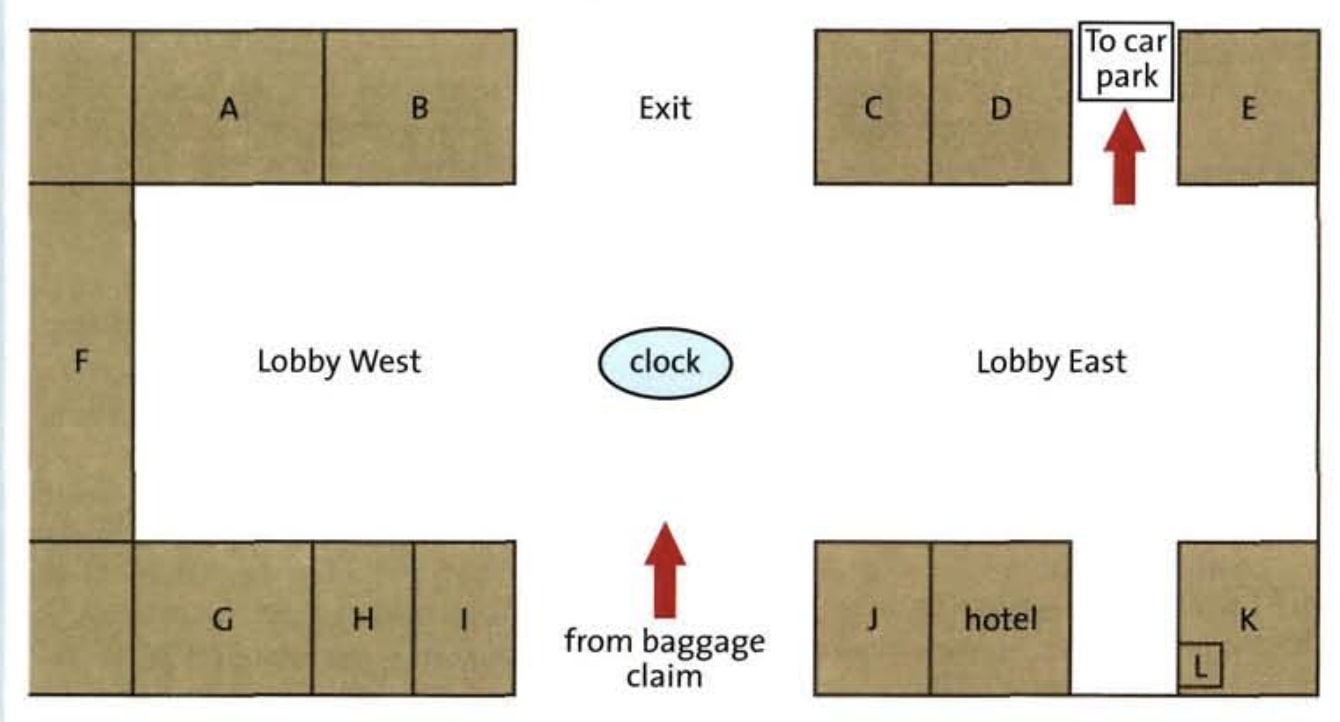Problem A. Listening ≡
| Maximum points: | 33 | Time limit: | 1 sec | |
| Memory limit: | 512 Mb |
Statement
LISTENING. Task 1
You will hear an interview with the television presenter Dan. For questions 1-6, choose the answer (A, B, C or D) which fits best according to what you hear. You will hear the recording only once.
Task 2
For questions 7-14 decide whether these statements are TRUE or FALSE. You are going to hear a writer called Peter Watkins being interviewed by the programme presenter, Sue Manchester. He is talking about his book, which discusses the behaviour of animals and birds in relation to the weather. You will hear the text once.
Task 3
For questions 15-20 label the plan below. Write the correct letter A-L next to the questions. You will hear a telephone conversation between two friends about a meeting in an airport terminal. You will hear the recording only once.

READING Task 4 Read the text and answer questions 21-40 below.
Plastics affect all of our lives - from packaging to cutting-edge technologies in cars and computers, from new textiles to replacements for worn-out parts of our bodies. But none of the applicants and innovations we take for granted would have been possible if it weren’t for the early scientists who developed and refined the material.
Plastics affect all of our lives - from packaging to cutting-edge technologies in cars and computers, from new textiles to replacements for worn-out parts of our bodies. But none of the applicants and innovations we take for granted would have been possible if it weren’t for the early scientists who developed and refined the material.
The first man-made plastic, Parkesine, was unveiled in London in 1862. This was an organic material derived from cellulose that once heated could be moulded, and on cooling retained its shape until it was reheated. But because of the high cost of raw materials, production soon came to an end.
During the 19th century, the game of billiards became so popular that thousands of elephants were killed for their ivory – used to make billiard balls. A replacement, celluloid, was found by an American, Hyatt, in 1866. On spilling a bottle of collodion, he discovered that the material congealed into a tough, flexible film. He then used it to produce billiard balls, but they shattered once they hit each other, a problem subsequently solved by the addition of camphor. Celluloid was the first thermoplastic: a substance that can be moulded under heat and pressure. Celluloid was later used in the first flexible photographic film for still and motion pictures.
Rayon, another modified cellulose, was the first developed in 1891 by the Frenchman Bernigaut, while searching for a way to produce man-made silk. Bernigaut noticed that silkworms secrete a liquid that hardens upon exposure to air and turns into silk. He produced a liquid with similar characteristics, which could then be processed to form fibres that could be spun and would feel like silk. The only problem with his new invention was that it was highly flammable. This prolbem was later solved by another scientist.
The first completely synthetic man-made substance was discovered in 1907, when Baekeland, a New York chemist, developed a liquid resin that he named Bakelite. All previous plastics could be melted down innumerable times and reformed. Bakelite, however, had the advantage that once shaped, it would never melt or burn. It could also be added to almost any material – such as softwood – and would instantly make it more durable and effective. This new material began to be used for a wide range of products.
Cellophane was discovered by Brandenberger, a Swisstextile engineer. He wanted to apply a clear flexible film to fabrics, such as tablecloths, so that they could be easily. In 1913 he succeeded by using Viscose (now known as Rayon), but this made the material too stiff to be of any use. Brandenberger saw another potential use, though. He produced sheets of it, which he marketed as Cellophane. This could be used as a clear layer of packaging for any product – the first fully flexible, waterproof wrap.
The 1920s witnessed a ‘plastic craze’, as the use of cellophane spread throughout the world. Nylon, initially discovered in Germany, was developed in the USA. Its toughness made it a suitable replacement for animal hair in toothbrushes, and when nylon stockings were launched in 1939, they gained great public acceptance.
In 1933 Fawcett and Gibson, two British organic chemists working for the company ICI, discovered polyethylene while testing various chemicals. An attempt to trigger a reaction between ethylene and benzaldehyde under high pressure went wrong when the testing seemed to spring a leak. Upon opening the tube the scientists found a waxy, plastic-like substance, polyethylene. After further experimentation and analysis, they discovered that while the process did have a small leak, the main cause of pressure loss was a polymerization process that combined elements. In 1936, ICI developed a compressor that made possible the production of vast quantities of polyethylene.
Polyethylene played a key role during World War II in the 1940s – first as an underwater cable coating and then as insulation for radar. As polyethylene was very much lighter than the materials traditionally used for the latter purpose, it was now possible for the first time to place radar on planes. This helped in the detection of enemy bombers at night.
After the war the material became very popular with consumers, and it is currently the largest volume plastic in the world, used to make a wide range of common items, such as plastic food storage containers.
QUESTIONS 21-26 Complete each sentence with the correct ending A-H from the box below
QUESTIONS 27-33 Complete the summary below.Choose NO MORE THAN ONE WORD from the passage for each answer.